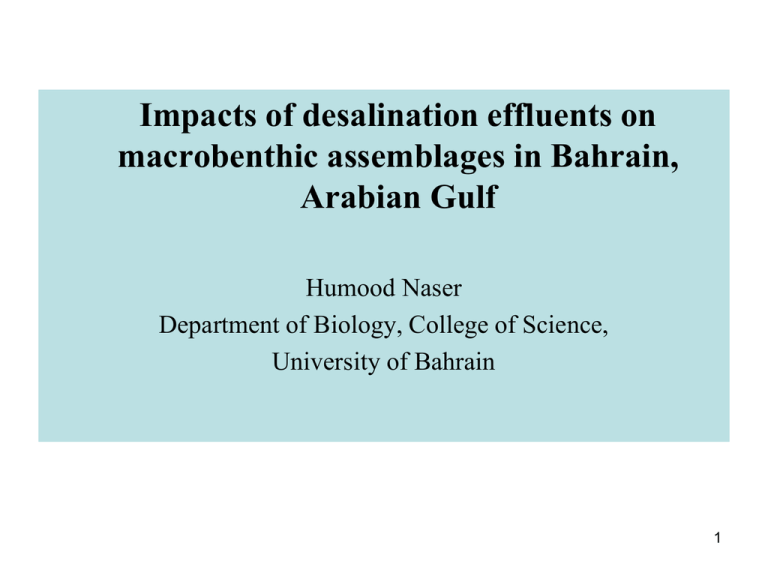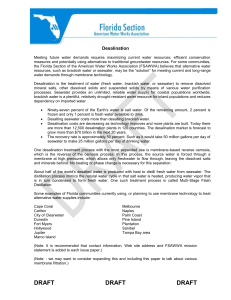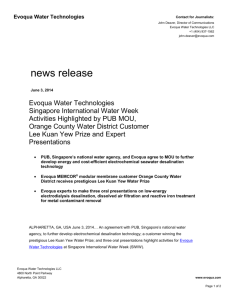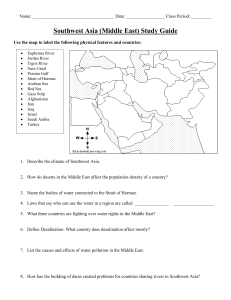Impacts of desalination effluents on macrobenthic assemblages in Bahrain, Arabian Gulf
advertisement

Impacts of desalination effluents on macrobenthic assemblages in Bahrain, Arabian Gulf Humood Naser Department of Biology, College of Science, University of Bahrain 1 Introduction • Arabian Gulf countries are characterized by low precipitation and high aridity. • Most of the fresh water needs are being obtained from seawater through the various processes of desalination. • Desalinations include Multi-Stage Flash (MSF), Reverse Osmosis (RO) technologies. 2 Desalination in Bahrain Plant Operation Technology date Water Effluents capacity m3 day-1 gallon day-1 Sitra Power and 1975 multi-stage flash 25 x 106 66 000 1984 underground water 12 x 106 1 500 Water Station Ras Abu-Jarjur Desalination Plant Addur Desalination reverse osmosis 1990 Seawater reserve osmosis 10 x 106 3 750 2000 multi-stage flash 30 x 106 8 000 plant Al-Hidd Power and Water Station Total 79 250 3 • Water discharges associated with chemical products from desalination plants are increasingly becoming a serious threat to coastal and marine ecosystems in the Arabian Gulf. • Receiving marine environments are typically subject to chemical and physical alterations that can subsequently affect benthic communities. 4 • Macrobenthic assemblages are useful and sensitive indicators for the quality of intertidal and subtidal marine environments. • The aim of this study was to assess the impacts of two desalination plants (MSF and brackish RO) on the abundance and biodiversity of macrobenthos inhabiting subtidal areas off the eastern coastline of Bahrain. 5 Materials and Methods Two desalination plants were selected 6 7 Sitra Power and Water Station (SPWS) (MFS) Inlet Outlet 8 Sitra Power and Water Station (SPWS) (MFS) 9 Ras Abu-Jarjur Desalination Plant (RADP) (RO) Outlet 10 Ras Abu-Jarjur Desalination Plant (RADP) (RO) Outlet 11 Sampling design Transect: 8 stations: 200m Desalination outlet Station: sediment sampling for benthos, physical and chemical analyses 12 Macrobenthos sampling 13 Macrobenthos sampling 14 Macrobenthos identification 15 Macrobenthos identification 16 Macrobenthos identification 17 Grain size analysis 18 Heavy metal digestion 19 Heavy metals analysis 20 Nutrient analysis in seawater 21 Results 22 SPWS (MSF) RAJDP (RO) Environmental parameters Depth (m) Water Temp. oC Salinity (PSU) % Organic content Mean sediment particle (ø) 1 5.0 35 48 2 1.1 27 46 3 0.9 21 45 4 3.3 21 45 5 6 7 7.5 10.8 9.9 21 21 21 45 45 45 8 8.3 21 45 1 1.3 21 45 2 1.9 21 45 3 4.0 21 45 4 5.0 21 45 5 5.5 21 45 6 5.3 21 46 7 5.9 21 46 8 6.4 21 46 1.20 1.90 2.10 2.67 4.03 4.70 6.36 4.71 3.96 5.90 4.24 3.55 2.19 2.93 3.82 3.91 0.20 0.21 0.21 0.23 2.66 2.77 3.19 2.10 2.23 2.24 2.25 1.08 1.68 2.07 2.78 2.71 23 Nutrients in seawater Ammonia 7.00 6.00 5.00 4.00 mg/l SPWS RADP 3.00 Standard 2.00 1.00 0.00 1 2 3 4 5 6 7 8 24 Nutrients in seawater Nitrate 1.20 1.00 mg/l 0.80 SPWS 0.60 RADP Standard 0.40 0.20 0.00 1 2 3 4 5 6 7 8 25 Nutrients in seawater Phosphate 2.50 2.00 1.50 mg/l SPWS RADP Standard 1.00 0.50 0.00 1 2 3 4 5 6 7 8 26 Metals in sediment Zn 90 80 70 mg/kg 60 50 SPWS RADP 40 30 20 10 0 1 2 3 4 5 6 7 8 27 Metals in sediment Cu 40 35 30 mg/kg 25 SPWS 20 RADP 15 10 5 0 1 2 3 4 5 6 7 8 28 Metals in sediment Cd 9.000 8.000 7.000 mglkg 6.000 5.000 SPWS RADP 4.000 3.000 2.000 1.000 0.000 1 2 3 4 5 6 7 8 29 Metals in sediment Pb 40 35 30 mg/kg 25 SPWS 20 RADP 15 10 5 0 1 2 3 4 5 6 7 8 30 Ecological indices SPWS (MSF) RAJDP (RO) 1 2 3 4 5 6 7 8 1 2 3 4 5 6 7 8 Number of species 4 5 8 10 10 9 5 9 20 17 16 24 25 23 19 18 Number of org. 0.02m-2 28 30 28 29 85 101 11 59 201 156 126 259 197 230 86 178 Species richness 0.90 1.18 2.10 2.67 2.03 1.73 1.67 1.96 3.58 3.17 3.10 4.14 4.54 4.05 4.04 3.40 Species evenness J' 0.75 0.75 0.81 0.91 0.83 0.54 0.85 0.77 0.65 0.79 0.80 0.82 0.79 0.80 0.81 0.72 Diversity H'(loge) 1.04 1.21 1.68 2.10 1.92 1.18 1.37 1.70 1.95 2.23 2.22 2.60 2.55 2.50 2.39 2.07 31 32 Community structure 2D Stress: 0.09 1 4 1 2 2 Similarity 3 6 Transect 3 40 4 5 8 7 2 5 1 68 7 33 Concluding remarks • Reduced levels of biodiversity and abundance were recorded in sampling stations adjacent to the outlet of MSF. • Brine effluents that associated with high temperatures, salinities, and a range of chemical and heavy metal pollutants may affect marine benthos. • Although localized severe impacts on benthos were detected, collective discharges of desalination effluents, may synergistically contribute to the degradation of the naturally stressed marine ecosystems and natural resources in the Arabian Gulf. 34 Thank you 35






